大学一年级下学期会计学原理-会计学原理名词解释
会计学原理名词解释
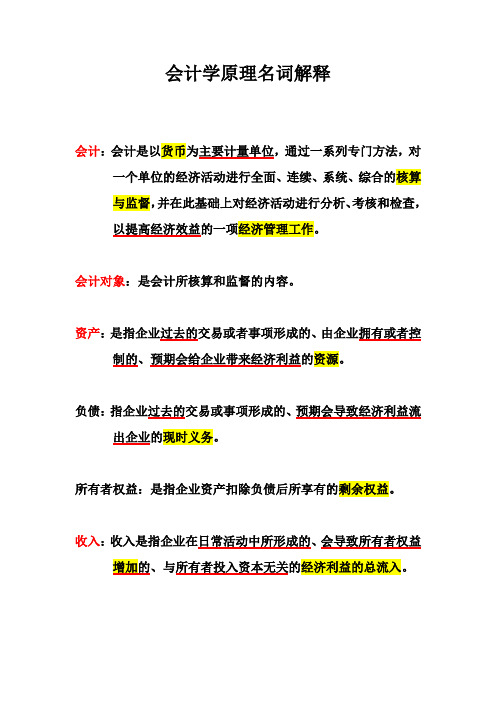
会计学原理名词解释会计:会计是以货币为主要计量单位,通过一系列专门方法,对一个单位的经济活动进行全面、连续、系统、综合的核算与监督,并在此基础上对经济活动进行分析、考核和检查,以提高经济效益的一项经济管理工作。
会计对象:是会计所核算和监督的内容。
资产:是指企业过去的交易或者事项形成的、由企业拥有或者控制的、预期会给企业带来经济利益的资源。
出企业的现时义务。
所有者权益:是指企业资产扣除负债后所享有的剩余权益。
增加的、与所有者投入资本无关的经济利益的总流入。
费用:是指企业在日常活动中发生的会导致所有者权益减少的、与向所有者分配利润无关的经济利益的总流出。
会计科目:是对会计要素的具体内容按照不同的经济内容和管理需要进行分类的项目。
会计账户:是根据会计科目开设的,具有一定结构,用来分类、复式记账法:是指对每笔交易、事项用相同的金额,同时在两个或两个以上相互联系的账户中登记的记账方法。
借贷记账法:是指以借、贷作为记账符号,按照“有借必有贷,借贷必相等”的记账规则,对发生的每一笔经济业务所引起的会计要素的变化,都在两个或两个以上的账户中,以相等的金额全面地、相互联系地进行会计分录:是指按照复式记账原理要求,确定每项经济业务应登记的账户、记账方向和应记金额的一种记录。
试算平衡:是指根据记账规则和会计恒等式来检查验证日常账户记录是否正确、完整的一种方法。
生产费用:管理费用:管理费用是指企业为组织和管理生产经营活动而发生的管理费用。
财务费用:指企业为筹集生产经营所需资金等而发生的筹资费用。
销售费用:是指企业在销售商品和材料、提供劳务的过程中发生的各种费用。
营业外收入:是指与企业生产经营活动没有直接关系的各种收入,是直接计入当期利润的利得。
营业外支出:是指不属于企业生产经营费用,与企业生产经营活动没有直接关系直接计入当期利润的损失。
交易性金融资产:是指具有活跃和频繁的买卖行为,并且以公允价值计量且其变动计入当期损益的金融资产。
会计学原理名词解释

1.Accounting会计(学): is an information and measurement system that id entifies records andcommunicates relevant reliabl e and comparabl e information about an organization’s businessactivities.2.Managerial accounting管理会计: is the area of accounting that serves the d ecision-marking needs ofinternal users3.Events项目: refer to happenings that affect an entity’s accounting equation and can be reliablymeasured.4.External user外部使用者: of accounting information are not directly involved in running theorganization.5.Internal user内部使用者: of accounting information are those directly efficiency and effectivenessof an organization.6.Ethics: are beliefs that distinguish right from wrong. They are accepted standards of good and badbehavior.7.Cost principl e(历史)成本原则: means that accounting information is based on actual cost.8.Revenue recognition principl e(营业)收入确定原则: provid es guidance on when a company mustrecognize revenue.9.Matching principl e配合原则,收支对应原则: prescribes that a company must records its expensesincurred to generate the revenue reported.10.Going-concerning assumption持续经营假设: means that accounting information refl ects apresumption that the business will continue operating instead of being cl osed or sol d.11.Audit审计,审核: through review of an organization’s accounting records and accounting reportsand return make by the analysis. income净收益,收益净额: amount a business earns after paying all expenses and costsassociated with its sales and revenues.13.Income statement损益表: d escribes a company’s revenues and expenses al on g with the resulting netincome or l oss over a period time due to earnings activities.14.Statement of owner’s equity所有者: explains changes in equity from net income (or l oss) and fromany owner investments and withdrawals over a period of time.15.Balance sheet资产负债表,平衡表: d escribes a company’s financial position (types and amounts ofassets liabilities and equity) at a point in time.16.Statement of cash fl ows现金流量表: id entifies cash infl ows (receipts) and cash outfl ows (payments)over a period of time.17.Owner’s withdr awals account所有者提款账户: the account used to record the transfers of assetsfrom a business to its owner.18.Liabilities负债: is what a company owes its no owners (creditors) in future payments, products, orservices.19.Accounting equation会计恒等式: Assets=Liabilities + Equity.20.Accrued expense应计费用,预提费用: refer to costs that are incurred in a period but are bothunpaid and unrecord ed.21.Operating cycl e:经营周期is the time span from when cash is used to acquire goods and servicesuntil cash is received from the sale of goods and services.22.Sharehol d ers (investors):股东,投资者are the owners of a corporation.23.Current radio:目前的广播电a ratio used to help evaluate a company’s ability to pay its d ebts in thenear future.24.Merchandise inventory:库存商品,商品盘存refers to products that a company owns and intends tosell.25.Cash discount:现金折扣,现金贴现reduction in a receivabl e or payabl e if it is paid within thediscount period. sellers can grant a cash discount to discourage buyers to pay earlier26.Gross profit:总利润also call ed Gross margin, which equals net sales cost of goods sold.27.Credit period:付款/信贷期限the amount of time all owed before full payment is due.28.Acid-test ratio酸性比率测试: a ratio used to assets a company’s ability to pay its current liabilities;d efined by current liabilities.29.Selling expense:销售费用includ e the expenses of promoting sales by displaying and advertisingmerchandise, making sales, and d elivering goods to customers.(P124)30.General and administrative expense(一般)管理费用: support a company’s overall operatio ns andinclud e expenses related to accounting, human resource management, and financial management. 31.Time period assumption: 会计分期假设presumes that the life of a company can be divid ed intotime periods, such as months and years, and that useful reports can be prepared for those periods.32.Account receivabl e:应收账款are held by a sell er and d ecreased by customers to sell ers.33.Prepaid account (also call ed prepaid expenses): 预付费用/待摊费用are assets that representprepayments of future expenses (not current expenses).34.Purchase discount:购物折扣purchaser’s d escripti on of a cash discount received from a supplier ofgoods.35.Sales discount:销售折扣sell er’s d escription of a cash discount granted to buyers in return for earlypayment.36.Trad e discount:商业折扣reduction below list or catalog price hat is negotiated in setting the price ofgoods.37.FOB shipping point (FOB factory):寄发地交货means the buyer accepts ownership when the goodsd epart the s eller’s place of business.38.FOB d estination: 目的地交货,离岸交货means ownership of goods transfers to the buyer when thegoods arrive at the b uyer’s pl ace of business.39.Credit terms: 信贷条件,赊销付款条件for a purchase includ e the amounts and timing of paymentsfrom a buy to a seller.40.Current assets:流动资产are cash and other resources that are expected to be sol d, coll ect, or usedwithin one year or the company’s op erating cycle, whichever is l onger.41.Plant assets: 固定资产refers to l ong-term tangibl e assets used to produce and sell products andservices.42.Long-term investment:长期投资notes receivabl e and investments in stocks and bonds are long-termassets when they are expected to be hel d for more than the l onger of one year or the operating cycl e.43.Intangibl e assets:无形资产are long-term resources that benefit business operations, usually lackphysical form, and have uncertain benefits. (P98)44.Current liabilities: 流动负债are obligations due to be paid or settled within one year or theoperating cycl e, whichever is l onger.(P98)45.Long-term liabilities长期负债: are obligations not due within one year or the operating cycl e,whichever is l onger.46.Accounting cycl e:会计周期refers to the steps in preparing financial statements.(P95)47.Temporary (or nominal) accounts:临时账户,名义账户accumulate data related to one accountingperiod.48.Permanent (or real) accounts:永久账户,实际账户report on activities related to one or more futureaccounting periods.49.account reveivabl e(应收账款)are liquid assets,usually being converted into cash within a period of30 to 60 days. Therefore, accounts receivabl e from customers are classified as current assets,appearing in the balance sheet immediately after cash and marketabl e securities.50.d oubl e entry accounting(复式记账法)is a standard accounting method that involves each transactionbeing record ed in at l east two accounts, resulting in a d ebit to one or more accounts and a credit to one or more accounts.51.materiality(重要性原则)refers to the magnitud e of an omission or misstatement of accountinginformation that, consid ering the circumstances ,make it likely that the judgment of a reasonabl e person relying on the information would have been influenced by the omission or misstatement. 52.perpetual inventory system(定期盘存制)Und er the perpetual inventory system,the inventoryrecords are kept up-to-date.Virtually all large business organizations use perpetual inventorysystems.53.unearned revenue(预收账款/预收收入)A liability for unearned revenue arises when a customerpays in advance.54.financial statement(财务报表)Four related accounting reports that summarize the current financialposition of an entity and the results of its operations for the preceding year(or other thim period) 55.historical cost(历史成本)The historical cost of an asset is the exchange price in the transaction inwhich the asset was acquired56.d epreciation(折旧)The systematic allocation of the cost of an asset to expense over the years of itsestimated useful57.accrued liabilities(应计负债)The liabilities to pay an expense which has accrued during theperiod.Accrued liabilities are also call ed accrued expenses.58.income(收入)is d efined as increases in economic benefits during the reporting period,in the form ofinfl ows or enhancements of assets,or d ecreases of liabilities tha result in increases in equity,other than those relating to contributions from equity participants.Income encompasses both revenue and gains.59.asset(资产)is a resource controll ed by the enterprise as a result of past events and from whichfuture economic benefits are expected to fl ow to the enterprise.60.account payabl e(应付账款)often are subdivid ed into categories of trad e accounts payabl e and otheraccounts payabl e.Trad e accounts payabl e are short—term obligations to suppliers for purchases or merchandise.Other accounts payabl e includ e liabilities for any goods and services other thanmerchandise.61.FIFO(先进先出法)A method of computing the cost of inventory and the cost of goods sold based onthe assumption that the first merchandise acquired is the first merchandise sol d,and that the ending inventory consists of the most recently acquired goods.62.Goodwill(商誉)The present value of expected future earnings of a business in excess of the earningsnormally realized in the industry.63.cost principl e(历史成本原则)The cost principl e states that assets shoul d by record ed at theircost.Cost is the value exchanged at the time something is acquired.64.权责发生制accrual basis of accounting: Means that revenues, expenses and other changes in assets,liabilities, and owners’ equity are accounted for in the period in which the economic event takes place, not necessarily when the cash infl ows and outfl ows take place利润表income statement :An income statement is a financial statement showing the results of operations for a business by matching revenue and related expenses for a particular accountingperiod .It shows the net income or net loss.永续盘存制perpetual inventory system: Is a system of accounting for merchandise that provid es a continuous record showing the quantity and cost of all goods on hand.总账账户control accounts: Grouped according to the el ements of financial statement, the general l edger hol ds the individual control accounts.费用Expense: Generally speaking, expenses are costs that are charged against ,revenue and that are related to the entity’s basic business.二简答题1.State the steps of establishing internal control over cash(简述建立现金内部控制的程序) (1)Separate the function of handling cash from the maintenance of accounting records(将现金收付与记账职务分离)(2)Prepare an immediate control listing of cash receipts at the time and place that themoney is received(在收到现金的当时当地编制一份现金收入控制清单)(3)Require that all cash receipts be d eposited daily in the bank(每日都要将现金收入存入银行)(4)Make all payments by check(所有的付款都以支票形式通过银行支付)(5)Separate the function of approving expenditures from the function of signing checks(将核准支出职务与签发支票职务分离)2.What are the quality chatacteristics of accounting information(会计信息质量特征):Rel evance(相关性),reliability(可靠性),und erstandability(可理解性),comparability(可比性)3.Describe the steps(procedures) of accounting cycl e(描述会计循环的步骤)(1)id entify transactions or events to be record ed(确认需要记录的交易或事项)(2)journalize transactions and events(将交易或事项登记到日记账)(3)posting from journal to l edger(从日记账过入)(4)prepare unadjusted trial balance(编制调整前余额试算表)(5)journalize and post adjusting journal entries(将调整分录计入日记账并过入分类账)(6)prepare adjusted trial balance(编制调整后余额试算表)(7)prepare financial statements(编制财务报表)(8)journalize and post cl osing entries(将结账分录计入日记账并过账)(9)prepare post-cl osing trial balance(编制结账后余额试算表)4.Briefly state the four assumptions and explain(简述四个会计假设)Separate entity(会计主体假设),going concern(持续经营假设).,time-period(会计分期假设),monetary unit(货币计量假设)5.Briefly state the classification investment in securities(简述有价证券的列报)Trading securities(交易性证券),held-to-maturity securities(持有至到期投资),availabl e-for-sale securities(可供出售的金融资产),l ong-term investment in equity securities(长期股权投资)6.What are the accounting el ements(会计要素)Assets(资产),liabilities(负债),owners’ equity(所有者权益),revenues(收入),expenses(费用),income (利润)d oubl e-entrybookkeeping 复式记账financial statement财务报表accounting equation 会计恒等式owner’s equity所有者权益retained earning 留存收益source d ocument原始凭证computerized accounting system 电算化会计系统accumulated d epreciation累计折旧Proprietorship所有权post-cl osing trial balance调整后试算accrued expense应计费用real/permanent account 实账户nominal/temporary account虚账户notes to the financial statements会计报表附注balance sheet资产负债表Accounting Standards for Business Enterprise 企业会计准则cash fl ow statement 现金流量表l ong-term solvency长期偿债能力short-term liquidity 短期偿债能力provision for bad d ebts 坏账准备construction in progress在建工程d eferred tax on d ebit/credit 递延税款借贷项estimabl e liabilities 预计负债paid-in captical 实收资本accounting treatment 会计处理current period 当期inflation 通货膨胀purchasing power 购买力profit distribution 理论分配accounting information 会计信息IASC 国际会计准则委员会FASB 财务会计准则委员会Liquidity 流动性cash equivalent 现金等价物Financial instrument 金融工具semifinished goods 半成品Low-value and perishabl e articles 低值易耗品weighted average 加权平均法accelerated d epreciation method 加速折旧法moving average 移动平均法trad emark 商标权Copyrights 著作权par value 票面价值sales all owances 销售折让cost variance 成本差异periodic expense 期间费用turnover tax 流转税non-operating expense 营业外支出theoretical framework 理论框架financial distress 财务困境current ratio 流动比例P/E ratio 市盈率M/B 市值与账面价值比capitalization ratio 资本比率Horizontal analysis 横向分析fiscal period 会计期间Vertical analysis 纵向分析price ind ex 价格指数subsidiary 子公司parent company 母公司generally accepted accounting principl es 公认会计准则calendar year 日历年度historical rate 历史汇率Receivabl es 应收账款payabl es 应付账款TQM 全面质量管理TOC 约束理论direct material 直接材料Ord er-getting cost 订单获取成本ord er-filling cost 订单获取成本process costing system 分布成本计算法job-ord er costing system 分批成本计算法step-variabl e cost 阶梯式成本cost formula 成本公式profit margin 贡献边际the high-l ow method 高低点法the scattergraph method 散布图法the least-squares regression method 最小二乘回归法cost behavior 成本性态。
会计学原理名词解释

会计的涵义:以货币为主要计量单位,运用专门的方法,对企业和行政、事业和行政等单位的经济活动进行核算和监督,对各单位的经济活动进行预测、参与决策,并对外提供符合会计准则的会计信息,以提高经济效益的管理活动。
资产:企业过去的交易或者事项形成的、由企业拥有或者控制的、预期会给企业带来经济利益的资源。
负债:过去的交易、事项形成的现时义务,履行该义务预期会导致经济利益流出企业。
所有者权益:企业投资者对企业净资产的所有权,实质上是所有者在企业资产中享有的经济利益,其金额等于资产减去负债。
收入:企业在日常活动中形成的、会导致所有者权益增加的、与所有者投入资本无关的经济利益的总流入。
费用:企业在日常活动中发生的、会导致所有者权益减少的、与向所有者分配利润无关的经济利益的总流出。
利润:企业在一定会计期间的经营成果,包括收入减去费用后的净额、直接计入当期利润的利得和损失等。
•利润总额=营业利润+当期利得-当期损失;•净利润=利润总额-所得税•资产=权益资产=负债+ 所有者权益……收入–费用= 利润(亏损)……会计凭证:会计凭证简称凭证,是记录经济业务发生和完成情况,明确经济责任,借以登记账簿的书面证明。
原始凭证:原始凭证是在经济业务发生或完成时取得或填制的,用来载明经济业务实际执行和完成情况,明确经济责任,具有法律效力,并作为记账的原始依据的一种会计凭证。
记账凭证:记账凭证是财会人员根据审核无误的原始凭证或原始凭证汇总表编制,用来记载经济业务的简要内容,并确定会计分录,直接作为记账依据的一种会计凭证。
累计凭证:是指在一定时期内连续在一张凭证中记载同类经济业务,并于期末将其累计数作为记账依据的原始凭证。
这种原始凭证,主要适用于某些经常重复发生的经济业务。
汇总原始凭证:是指在实际工作中为了集中反映某项经济业务的总括情况,简化记账凭证的填制工作而根据同类原始凭证编制的据以记账的汇总表。
复式记账凭证:是把一项经济业务所涉及的会计科目集中在一张记账凭证中填列,用以完整地反应经济业务的全貌和会计科目间的对应关系的一种记账凭证。
会计学原理名词解释整理(全)
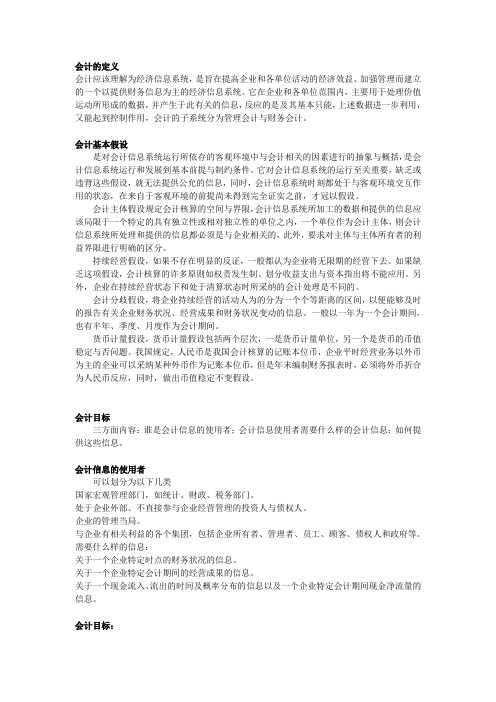
会计的定义会计应该理解为经济信息系统,是旨在提高企业和各单位活动的经济效益、加强管理而建立的一个以提供财务信息为主的经济信息系统。
它在企业和各单位范围内,主要用于处理价值运动所形成的数据,并产生于此有关的信息,反应的是及其基本只能,上述数据进一步利用,又能起到控制作用,会计的子系统分为管理会计与财务会计。
会计基本假设是对会计信息系统运行所依存的客观环境中与会计相关的因素进行的抽象与概括,是会计信息系统运行和发展到基本前提与制约条件。
它对会计信息系统的运行至关重要,缺乏或违背这些假设,就无法提供公允的信息,同时,会计信息系统时刻都处于与客观环境交互作用的状态,在来自于客观环境的前提尚未得到完全证实之前,才冠以假设。
会计主体假设规定会计核算的空间与界限,会计信息系统所加工的数据和提供的信息应该局限于一个特定的具有独立性或相对独立性的单位之内,一个单位作为会计主体,则会计信息系统所处理和提供的信息都必须是与企业相关的,此外,要求对主体与主体所有者的利益界限进行明确的区分。
持续经营假设,如果不存在明显的反证,一般都认为企业将无限期的经营下去。
如果缺乏这项假设,会计核算的许多原则如权责发生制、划分收益支出与资本指出将不能应用。
另外,企业在持续经营状态下和处于清算状态时所采纳的会计处理是不同的。
会计分歧假设,将企业持续经营的活动人为的分为一个个等距离的区间,以便能够及时的报告有关企业财务状况、经营成果和财务状况变动的信息。
一般以一年为一个会计期间,也有半年、季度、月度作为会计期间。
货币计量假设,货币计量假设包括两个层次,一是货币计量单位,另一个是货币的币值稳定与否问题。
我国规定,人民币是我国会计核算的记账本位币,企业平时经营业务以外币为主的企业可以采纳某种外币作为记账本位币,但是年末编制财务报表时,必须将外币折合为人民币反应,同时,做出币值稳定不变假设。
会计目标三方面内容:谁是会计信息的使用者;会计信息使用者需要什么样的会计信息;如何提供这些信息。
会计学原理名词解释

会计学原理名词解释会计学原理名词解释1.复式记账法“单式记账法”的对称。
对每项经济业务按相等金额在两个或两个以上有关账户中同时进行登记的方法。
2.权责发生制也称应收应付制或应计制,是指以经济的权益和责任的发生,即应收应付作为确定本期收入和费用的标准。
3.负债是指过去的交易、事项形成的现有义务,履行该义务预期会导致经济利益流出企业。
4.损益表又称利润表, 是用以反映公司在一定期间利润实现(或发生亏损)的财务报表。
5.预提费用是指企业按规定预先提取但尚未实际支付的各项费用。
6.会计要素会计要素就是对会计对象的具体内容所做的分类,是会计对象按经济特征所作的最基本分类,也是会计核算对象的具体化。
可以划分为资产、负债、所有者权益、收入、成本、费用和利润六个方面。
7.期间费用是指企业本期发生的、不能直接或间接归入营业成本,而是直接计入当期损益的各项费用。
包括经营费用、管理费用和财务费用等。
8.资产资产是企业,自然人,国家拥有或者控制的能以货币来计量收支的经济资源,包括各种收入、债权和其他。
9.会计帐簿“会计报表”的对称。
记载商主体营业交易和财产出入事项的会计记录文书。
为商业帐簿的一种。
10.红字冲销法红字冲销法又称红字更正法也称红字调整法,即先用红字编制一套与错账完全相同的记账凭证,予以冲销,然后再用蓝字编制一套正确的会计分录。
11.会计会计是以货币为主要计量单位,对企业、事业、机关、团体、深圳齐创辉财务代理公司及其他经济组织的经济活动进行记录、计算、控制、分析、报告,以提供财务和管理信息的工作。
12.产品成本由于生产的连续性,在一部分产品生产完毕成为产成品后,还有一些产品尚未完工而形成在产品,这样就需要在一定时点(一般为月末),将生产成本按照一定的方法,在产成品与在产品之间进行分配。
分配后,产成品所分担的生产成本,即为“产品成本”,而在产品所分担的部分,继续留在生产成本中,待其完工后比照上述办法处理。
13.会计主体会计主体或称会计实体,是指会计工作为其服务的特定单位或组织。
会计学原理名词解释
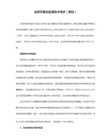
财务会计报告:是指企业对外提供的反映企业某一特定日期的财务状况和某一会计期间的经营成果、现金流量等会计信息的文件。
资产负债表:亦称财务状况表,表示企业在一定日期(月末、季末、半年末、年末)的财务状况报表。
利润表:又称损益表,是反映企业在一定会计期间经营成果的报表。
现金流量表:是以现金为基础编制的,反映企业一定期间内现金增减变动情况(流入和流出)的报表。
资本公积:是指企业在经营过程中由于接受捐赠、股本溢价以及法定财产重估增值等原因所形成的公积金。
盈余公积:是指公司按照规定从净利润中提取的各种积累资金。
未分配利润:是企业实现的净利润经过弥补亏损、提取盈余公积和向投资者分配利润后留存在企业的、历年结存的利润。
收入:是指企业在销售商品、提供劳务及让渡资产使用权等日常活动中所形成的、会导致所有者权益增加的、与所有者投入资本无关的经济利益的总流入。
科目汇总表核算组织程序:是定期将收款凭证、付款凭证和转账凭证按会计科目进行汇总,编制科目汇总表,再据以登记总账的一种会计核算组织程序。
永续盘存制:也称账面盘存制,就是通过设置存货明细账,对日常发生的存货增加或减少进行连续登记,并随时在账面上结算各项存货的结存数并定期与实际盘存数对比,确定存货盘盈盘亏的一种制度。
费用:是指企业在销售商品、提供劳务及让渡资产使用权等日常活动中发生的会导致所有者权益减少的、与向所有者分配利润无关的经济利益的总流出。
直接费用:是指直接为生产产品而发生的各项费用,包括直接材料费、直接人工费和其他直接支出。
间接费用:是指企业内部生产经营单位为组织和管理生产经营活动而发生的共同费用和不能直接计入产品成本的各项费用。
复式记账:是指对每一笔经济业务都要以相等的金额,同时在两个或两个以上相互联系的账户中进行登记的记账方法。
会计学原理是什么
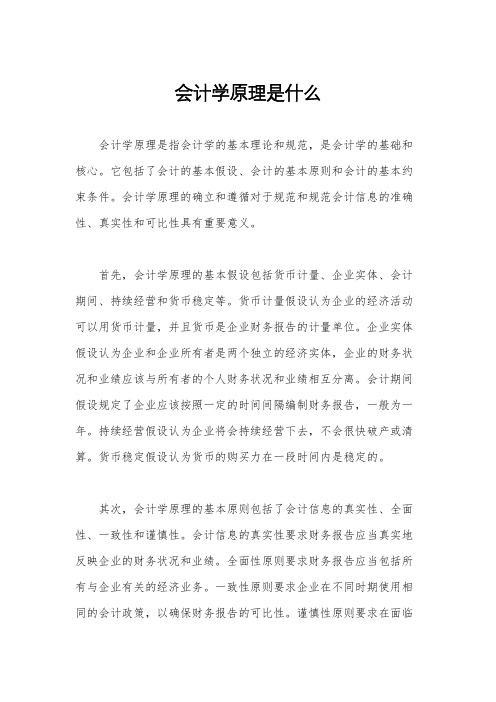
会计学原理是什么会计学原理是指会计学的基本理论和规范,是会计学的基础和核心。
它包括了会计的基本假设、会计的基本原则和会计的基本约束条件。
会计学原理的确立和遵循对于规范和规范会计信息的准确性、真实性和可比性具有重要意义。
首先,会计学原理的基本假设包括货币计量、企业实体、会计期间、持续经营和货币稳定等。
货币计量假设认为企业的经济活动可以用货币计量,并且货币是企业财务报告的计量单位。
企业实体假设认为企业和企业所有者是两个独立的经济实体,企业的财务状况和业绩应该与所有者的个人财务状况和业绩相互分离。
会计期间假设规定了企业应该按照一定的时间间隔编制财务报告,一般为一年。
持续经营假设认为企业将会持续经营下去,不会很快破产或清算。
货币稳定假设认为货币的购买力在一段时间内是稳定的。
其次,会计学原理的基本原则包括了会计信息的真实性、全面性、一致性和谨慎性。
会计信息的真实性要求财务报告应当真实地反映企业的财务状况和业绩。
全面性原则要求财务报告应当包括所有与企业有关的经济业务。
一致性原则要求企业在不同时期使用相同的会计政策,以确保财务报告的可比性。
谨慎性原则要求在面临不确定性的情况下,应当对不利情况进行足够的提前预测和计提。
最后,会计学原理的基本约束条件包括了成本约束、谨慎约束、收入确认约束和匹配约束。
成本约束要求企业应当按照成本原则进行资产的计量和负债的计量。
谨慎约束要求在面临不确定性的情况下,应当对不利情况进行足够的提前预测和计提。
收入确认约束要求企业应当在实现收入的条件下确认收入。
匹配约束要求企业应当将相关的收入和费用进行匹配,以便真实地反映企业的经济业绩。
综上所述,会计学原理是会计学的基本理论和规范,包括了基本假设、基本原则和基本约束条件。
遵循会计学原理有助于规范和规范会计信息的准确性、真实性和可比性,对于企业的经营决策、投资决策和信贷决策具有重要意义。
因此,了解和遵循会计学原理对于提高企业的财务管理水平和经营绩效具有重要意义。
(完整版)会计学原理名词解释和简答
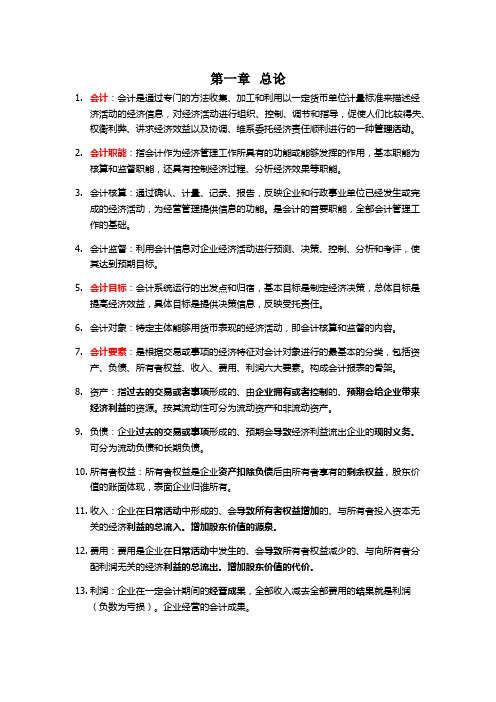
第一章总论1.会计:会计是通过专门的方法收集、加工和利用以一定货币单位计量标准来描述经济活动的经济信息,对经济活动进行组织、控制、调节和指导,促使人们比较得失、权衡利弊、讲求经济效益以及协调、维系委托经济责任顺利进行的一种管理活动。
2.会计职能:指会计作为经济管理工作所具有的功能或能够发挥的作用,基本职能为核算和监督职能,还具有控制经济过程、分析经济效果等职能。
3.会计核算:通过确认、计量、记录、报告,反映企业和行政事业单位已经发生或完成的经济活动,为经营管理提供信息的功能。
是会计的首要职能,全部会计管理工作的基础。
4.会计监督:利用会计信息对企业经济活动进行预测、决策、控制、分析和考评,使其达到预期目标。
5.会计目标:会计系统运行的出发点和归宿,基本目标是制定经济决策,总体目标是提高经济效益,具体目标是提供决策信息,反映受托责任。
6.会计对象:特定主体能够用货币表现的经济活动,即会计核算和监督的内容。
7.会计要素:是根据交易或事项的经济特征对会计对象进行的最基本的分类,包括资产、负债、所有者权益、收入、费用、利润六大要素。
构成会计报表的骨架。
8.资产:指过去的交易或者事项形成的、由企业拥有或者控制的、预期会给企业带来经济利益的资源。
按其流动性可分为流动资产和非流动资产。
9.负债:企业过去的交易或事项形成的、预期会导致经济利益流出企业的现时义务。
可分为流动负债和长期负债。
10.所有者权益:所有者权益是企业资产扣除负债后由所有者享有的剩余权益,股东价值的账面体现,表面企业归谁所有。
11.收入:企业在日常活动中形成的、会导致所有者权益增加的、与所有者投入资本无关的经济利益的总流入。
增加股东价值的源泉。
12.费用:费用是企业在日常活动中发生的、会导致所有者权益减少的、与向所有者分配利润无关的经济利益的总流出。
增加股东价值的代价。
13.利润:企业在一定会计期间的经营成果,全部收入减去全部费用的结果就是利润(负数为亏损)。
会计学原理名词解释
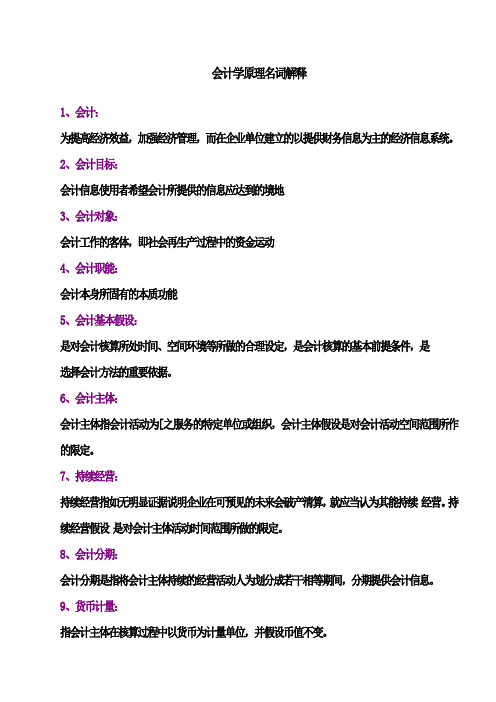
会计学原理名词解释1、会计:为提高经济效益,加强经济管理,而在企业单位建立的以提供财务信息为主的经济信息系统。
2、会计目标:会计信息使用者希望会计所提供的信息应达到的境地3、会计对象:会计工作的客体,即社会再生产过程中的资金运动4、会计职能:会计本身所固有的本质功能5、会计基本假设:是对会计核算所处时间、空间环境等所做的合理设定,是会计核算的基本前提条件,是选择会计方法的重要依据。
6、会计主体:会计主体指会计活动为[之服务的特定单位或组织,会计主体假设是对会计活动空间范围所作的限定。
7、持续经营:持续经营指如无明显证据说明企业在可预见的未来会破产清算,就应当认为其能持续经营。
持续经营假设是对会计主体活动时间范围所做的限定。
8、会计分期:会计分期是指将会计主体持续的经营活动人为划分成若干相等期间,分期提供会计信息。
9、货币计量:指会计主体在核算过程中以货币为计量单位,并假设币值不变。
10、会计确认:根据一定标准,辨别经济业务数据能否、何时进入会计信息系统,如何进行报告的过程。
11、会计计量:是对具体会计要素按货币量度进行量化的程序,主要解决计量尺度、计量属性问题。
12、资产:企业过去的交易或事项形成的,由企业拥有或控制的,预期会给企业带来经济利益的资源。
13、负债:企业过去交易或事项形成的,预期会导致经济利益流出企业的现时义务。
14、所有者权益:企业资产扣除负债后,由所有者享有的剩余权益。
15、收入:企业在日常经营活动中形成的,与所有者投入资本无关的,会导致所有者权益增加的经济利益流入。
16、费用:企业在日常经营活动中发生的,与所有者分配无关的,会导致所有者权益减少的经济利益流出。
17、利润:企业在一定会计期间的经营成果,包括收入减去费用的净额、直接计入当期利润的利得和损失。
18、成本:企业为生产产品、提供劳务而发生的各种耗费,可分为产品费用、期间费用。
19、权责发生制:会计核算中以权利形成时间决定收入归属期间,以责任发生时间决定费用归属期间。
会计学原理名词解释

会计学原理名词解释会计学原理是会计学的基础性理论,它用来解释会计实务中的各种现象和规则。
下面是会计学原理中的一些重要概念的解释:1.核算主体:核算主体也叫会计主体,指的是拥有自己独立的财务状况和经营活动的组织、个人或其他经济单位。
核算主体可以是企业、政府部门、非营利组织等。
2.会计要素:会计要素是指会计报告中所包含的主要元素,包括资产、负债、所有者权益、收入和费用。
这五个要素是会计报告的核心内容。
3.会计等式:会计等式是一种重要的会计原理,表达了会计核算的基本关系。
会计等式的公式表示为:资产=负债+所有者权益。
这个等式反映了经济实体资源的来源和运用。
4.货币计量原则:货币计量原则是会计学中的一条重要原则,它规定会计报告中的各种经济事项必须以货币单位来计量和表达。
这种计量方式能够确保财务报表的可比性和可理解性。
5.持续经营原则:持续经营原则也叫连续经营原则,是指会计假设中的一条基本假设,它规定核算主体将会持续经营并保持其活动的正常状态。
根据这一原则,会计报告应当基于持续经营的假设进行编制。
6.主体内容一致原则:主体内容一致原则是指会计报告应当展示核算主体的全部经济实质和财务状况,不能遗漏或夸大重要信息。
这一原则强调会计报告的真实性、可靠性和完整性。
7.成本原则:成本原则是会计学中的一条重要原则,它规定会计报告中的各种资产应当以其购置成本或成本价值进行核算和评估。
这种原则能够提供资产真实价值的信息。
8.分期核算原则:分期核算原则是指会计报告应当根据时间周期进行编制,即将长时间期限内发生的经济事项进行划分,确认为不同的会计期间进行核算和报告。
以上是会计学原理中的一些重要概念的解释。
这些概念对于理解和应用会计学原理非常重要,能够帮助我们更好地理解和运用会计知识。
会计学原理名词解释

会计学原理名词解释
会计学原理是指会计学的基本概念、原则和规则,是会计学的理论基础。
它包括以下几个方面的内容:
1. 会计实体:指企业、组织或个人等经济活动主体,是进行会计核算的基本单位。
2. 会计要素:指会计核算中具体反映会计实体财务状况和经营成果的基本要素,包括资产、负债、所有者权益、收入和费用。
3. 记账:指将经济交易和事项记录在会计簿中,是会计核算的基本环节。
记账应遵循借贷规则,即每一笔交易都有相应的借方和贷方。
4. 会计凭证:指原始凭证和会计人员根据原始凭证制作的会计凭证,用于记载和证明经济交易的发生和真实性。
5. 会计账簿:指用来记载和分类会计凭证的簿册,包括总账、明细账和资产负债表等。
6. 会计报表:指会计核算结果的定期总结和呈现,包括资产负债表、利润表、现金流量表和所有者权益变动表等。
7. 会计原则:指会计核算必须遵循的基本原则,包括会计实体主体性原则、会计周期性原则、货币计量原则、权责发生制原则、持续经营原则等。
8. 会计伦理:指会计人员在从事会计工作中应遵循的道德规范和职业操守,包括诚信、保密、独立和专业行为等。
这些原理和概念构成了会计学的基本框架和规范,是进行会计核算和分析的基础。
会计学原理名词解释
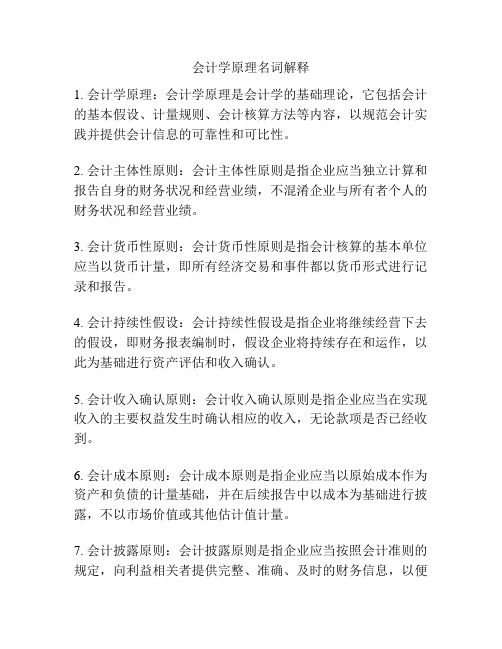
会计学原理名词解释1. 会计学原理:会计学原理是会计学的基础理论,它包括会计的基本假设、计量规则、会计核算方法等内容,以规范会计实践并提供会计信息的可靠性和可比性。
2. 会计主体性原则:会计主体性原则是指企业应当独立计算和报告自身的财务状况和经营业绩,不混淆企业与所有者个人的财务状况和经营业绩。
3. 会计货币性原则:会计货币性原则是指会计核算的基本单位应当以货币计量,即所有经济交易和事件都以货币形式进行记录和报告。
4. 会计持续性假设:会计持续性假设是指企业将继续经营下去的假设,即财务报表编制时,假设企业将持续存在和运作,以此为基础进行资产评估和收入确认。
5. 会计收入确认原则:会计收入确认原则是指企业应当在实现收入的主要权益发生时确认相应的收入,无论款项是否已经收到。
6. 会计成本原则:会计成本原则是指企业应当以原始成本作为资产和负债的计量基础,并在后续报告中以成本为基础进行披露,不以市场价值或其他估计值计量。
7. 会计披露原则:会计披露原则是指企业应当按照会计准则的规定,向利益相关者提供完整、准确、及时的财务信息,以便他们能够全面了解和评价企业的财务状况和经营业绩。
8. 会计匹配原则:会计匹配原则是指企业应当按照收入和相关成本发生的时期进行配比,即在财务报表上将各期的收入与相关的成本相对照,以达到真实反映企业经营成果的目的。
9. 会计准则:会计准则是会计学原理的具体规定,包括指导会计核算、报表编制和披露的基本原则、具体内容和政策规定的系统化体系。
不同国家和地区有不同的会计准则,如中国的《企业会计准则》和美国的《美国通用会计准则》等。
10. 会计核算:会计核算是指按照会计学原理和会计准则,将企业经济交易和事件的各项元素进行记录、分类、总结和报告的过程,以编制财务报表和提供会计信息。
会计学原理名词解释
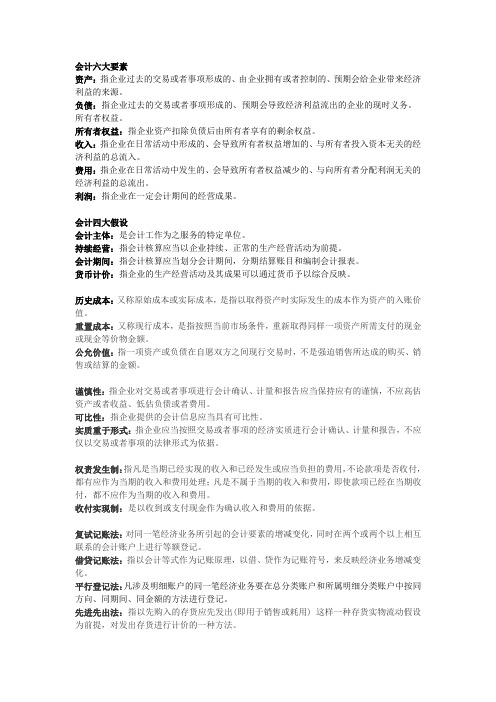
会计六大要素资产:指企业过去的交易或者事项形成的、由企业拥有或者控制的、预期会给企业带来经济利益的来源。
负债:指企业过去的交易或者事项形成的、预期会导致经济利益流出的企业的现时义务。
所有者权益。
所有者权益:指企业资产扣除负债后由所有者享有的剩余权益。
收入:指企业在日常活动中形成的、会导致所有者权益增加的、与所有者投入资本无关的经济利益的总流入。
费用:指企业在日常活动中发生的、会导致所有者权益减少的、与向所有者分配利润无关的经济利益的总流出。
利润:指企业在一定会计期间的经营成果。
会计四大假设会计主体:是会计工作为之服务的特定单位。
持续经营:指会计核算应当以企业持续、正常的生产经营活动为前提。
会计期间:指会计核算应当划分会计期间,分期结算账目和编制会计报表。
货币计价:指企业的生产经营活动及其成果可以通过货币予以综合反映。
历史成本:又称原始成本或实际成本,是指以取得资产时实际发生的成本作为资产的入账价值。
重置成本:又称现行成本,是指按照当前市场条件,重新取得同样一项资产所需支付的现金或现金等价物金额。
公允价值:指一项资产或负债在自愿双方之间现行交易时,不是强迫销售所达成的购买、销售或结算的金额。
谨慎性:指企业对交易或者事项进行会计确认、计量和报告应当保持应有的谨慎,不应高估资产或者收益、低估负债或者费用。
可比性:指企业提供的会计信息应当具有可比性。
实质重于形式:指企业应当按照交易或者事项的经济实质进行会计确认、计量和报告,不应仅以交易或者事项的法律形式为依据。
权责发生制:指凡是当期已经实现的收入和已经发生或应当负担的费用,不论款项是否收付,都有应作为当期的收入和费用处理;凡是不属于当期的收入和费用,即使款项已经在当期收付,都不应作为当期的收入和费用。
收付实现制:是以收到或支付现金作为确认收入和费用的依据。
复试记账法:对同一笔经济业务所引起的会计要素的增减变化,同时在两个或两个以上相互联系的会计账户上进行等额登记。
会计学原理-名词解释1-8章(没有打完,想要的看一下)
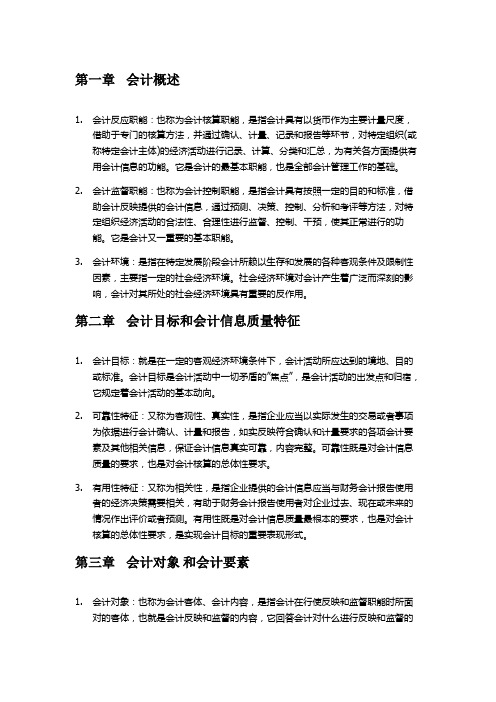
第一章会计概述1.会计反应职能:也称为会计核算职能,是指会计具有以货币作为主要计量尺度,借助于专门的核算方法,并通过确认、计量、记录和报告等环节,对特定组织(或称特定会计主体)的经济活动进行记录、计算、分类和汇总,为有关各方面提供有用会计信息的功能。
它是会计的最基本职能,也是全部会计管理工作的基础。
2.会计监督职能:也称为会计控制职能,是指会计具有按照一定的目的和标准,借助会计反映提供的会计信息,通过预测、决策、控制、分析和考评等方法,对特定组织经济活动的合法性、合理性进行监督、控制、干预,使其正常进行的功能。
它是会计又一重要的基本职能。
3.会计环境:是指在特定发展阶段会计所赖以生存和发展的各种客观条件及限制性因素,主要指一定的社会经济环境。
社会经济环境对会计产生着广泛而深刻的影响,会计对其所处的社会经济环境具有重要的反作用。
第二章会计目标和会计信息质量特征1.会计目标:就是在一定的客观经济环境条件下,会计活动所应达到的境地、目的或标准。
会计目标是会计活动中一切矛盾的”焦点”,是会计活动的出发点和归宿,它规定着会计活动的基本动向。
2.可靠性特征:又称为客观性、真实性,是指企业应当以实际发生的交易或者事项为依据进行会计确认、计量和报告,如实反映符合确认和计量要求的各项会计要素及其他相关信息,保证会计信息真实可靠,内容完整。
可靠性既是对会计信息质量的要求,也是对会计核算的总体性要求。
3.有用性特征:又称为相关性,是指企业提供的会计信息应当与财务会计报告使用者的经济决策需要相关,有助于财务会计报告使用者对企业过去、现在或未来的情况作出评价或者预测。
有用性既是对会计信息质量最根本的要求,也是对会计核算的总体性要求,是实现会计目标的重要表现形式。
第三章会计对象和会计要素1.会计对象:也称为会计客体、会计内容,是指会计在行使反映和监督职能时所面对的客体,也就是会计反映和监督的内容,它回答会计对什么进行反映和监督的问题。
会计学原理的名词解释

1.会计:会计是以货币为主要计量单位,反映和监督一个单位经济活动的一种经济管理工作.会计——是经济管理的重要组成部分,是以货币为主要计量尺度,对经济活动进行连续、系统和综合的核算,提供以财务信息为主的经济信息,既为外部有关各方的投资、信贷决策服务,也为内部强化管理和提高经济效益服务,是一个生成和提供财务信息并用于管理的系统。
会计要素——就是对会计内容的基本分类,即将会计内容分解而成若干个要素,统称为会计要素。
2.持续经营:持续经营是指会计信息系统的运行以会计主体继续存在并执行其预定的经营活动为前提。
除非有充分的相反证明,否则,都将认为每一个会计主体能无限期地连续经营下去。
3.会计分期:会计分期是指会计信息应按划分期限收集和处理。
会计分期假设是持续经营假设的一个必要的补充。
如果假设一个会计主体应持续经营而无期限,在逻辑上就要为会计信息的提供规定期限。
这是会计这一信息系统的发挥作用的前提。
4. 客观性原则:以实际发生的交易或事项为依据如实反映企业财务状况、经营成果和现金流量。
也叫真实性原则。
5. 谨慎性原则:是指企业在处理未来不确定的经济事项时必须持谨慎态度。
凡是没有绝对把握实现的收入,不能人为虚拟入账;凡是可以预见的,并且应列入本期成本的支出,都应列入本期损益。
所有真正意义上的企业,面对的都是一个有风险的市场,其经营活动都存在着大量的不确定因素,因此,在处理未来不确定的经济事项时,必须持谨慎态度。
人为虚拟收入,下甩支出,必然形成泡沫经济,带来虚假繁荣。
6. 会计要素:是对会计对象所作的基本分类,是会计核算对象的具体化,是用于反映会计主体财务状况和经营成果的基本单位。
由于会计要素是对会计对象的分类,所以会计要素是主观的,也就是说,不同的国家可以有不同的会计要素。
我国《企业会计准则》将会计要素界定为六个,即资产、负债、所有者权益、收入、费用和利润。
7.资产:资产是指企业过去的交易或事项形成的、由企业拥有或者控制的、预期会给企业带来经济利益的资源。
(完整版)会计学原理名词解释
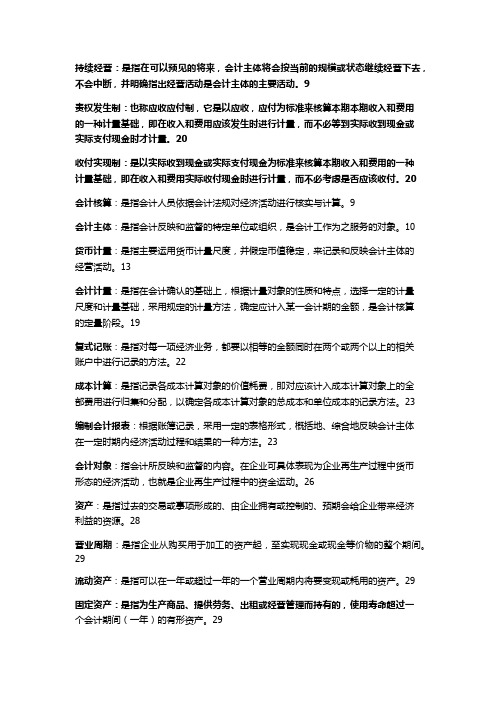
持续经营:是指在可以预见的将来,会计主体将会按当前的规模或状态继续经营下去,不会中断,并明确指出经营活动是会计主体的主要活动。
9责权发生制:也称应收应付制,它是以应收,应付为标准来核算本期本期收入和费用的一种计量基础,即在收入和费用应该发生时进行计量,而不必等到实际收到现金或实际支付现金时才计量。
20收付实现制:是以实际收到现金或实际支付现金为标准来核算本期收入和费用的一种计量基础,即在收入和费用实际收付现金时进行计量,而不必考虑是否应该收付。
20会计核算:是指会计人员依据会计法规对经济活动进行核实与计算。
9会计主体:是指会计反映和监督的特定单位或组织,是会计工作为之服务的对象。
10货币计量:是指主要运用货币计量尺度,并假定币值稳定,来记录和反映会计主体的经营活动。
13会计计量:是指在会计确认的基础上,根据计量对象的性质和特点,选择一定的计量尺度和计量基础,采用规定的计量方法,确定应计入某一会计期的金额,是会计核算的定量阶段。
19复式记账:是指对每一项经济业务,都要以相等的金额同时在两个或两个以上的相关账户中进行记录的方法。
22成本计算:是指记录各成本计算对象的价值耗费,即对应该计入成本计算对象上的全部费用进行归集和分配,以确定各成本计算对象的总成本和单位成本的记录方法。
23编制会计报表:根据账簿记录,采用一定的表格形式,概括地、综合地反映会计主体在一定时期内经济活动过程和结果的一种方法。
23会计对象:指会计所反映和监督的内容。
在企业可具体表现为企业再生产过程中货币形态的经济活动,也就是企业再生产过程中的资金运动。
26资产:是指过去的交易或事项形成的、由企业拥有或控制的、预期会给企业带来经济利益的资源。
28营业周期:是指企业从购买用于加工的资产起,至实现现金或现金等价物的整个期间。
29流动资产:是指可以在一年或超过一年的一个营业周期内将要变现或耗用的资产。
29固定资产:是指为生产商品、提供劳务、出租或经营管理而持有的,使用寿命超过一个会计期间(一年)的有形资产。
会计学原理名词解释与简答
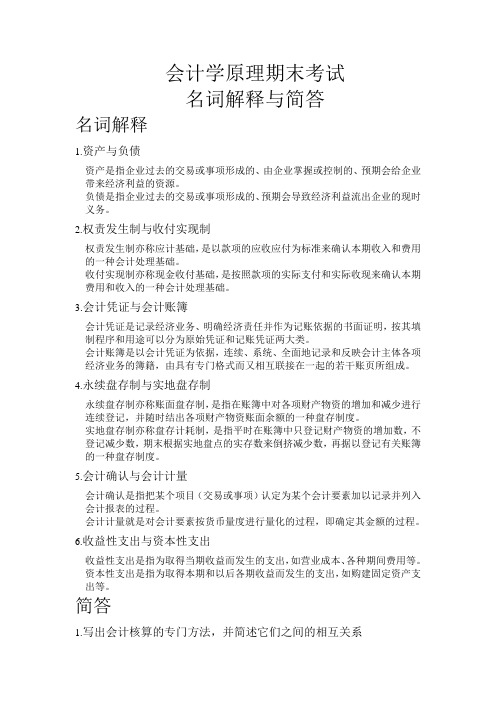
会计学原理期末考试名词解释与简答名词解释1.资产与负债资产是指企业过去的交易或事项形成的、由企业掌握或控制的、预期会给企业带来经济利益的资源。
负债是指企业过去的交易或事项形成的、预期会导致经济利益流出企业的现时义务。
2.权责发生制与收付实现制权责发生制亦称应计基础,是以款项的应收应付为标准来确认本期收入和费用的一种会计处理基础。
收付实现制亦称现金收付基础,是按照款项的实际支付和实际收现来确认本期费用和收入的一种会计处理基础。
3.会计凭证与会计账簿会计凭证是记录经济业务、明确经济责任并作为记账依据的书面证明,按其填制程序和用途可以分为原始凭证和记账凭证两大类。
会计账簿是以会计凭证为依据,连续、系统、全面地记录和反映会计主体各项经济业务的簿籍,由具有专门格式而又相互联接在一起的若干账页所组成。
4.永续盘存制与实地盘存制永续盘存制亦称账面盘存制,是指在账簿中对各项财产物资的增加和减少进行连续登记,并随时结出各项财产物资账面余额的一种盘存制度。
实地盘存制亦称盘存计耗制,是指平时在账簿中只登记财产物资的增加数,不登记减少数,期末根据实地盘点的实存数来倒挤减少数,再据以登记有关账簿的一种盘存制度。
5.会计确认与会计计量会计确认是指把某个项目(交易或事项)认定为某个会计要素加以记录并列入会计报表的过程。
会计计量就是对会计要素按货币量度进行量化的过程,即确定其金额的过程。
6.收益性支出与资本性支出收益性支出是指为取得当期收益而发生的支出,如营业成本、各种期间费用等。
资本性支出是指为取得本期和以后各期收益而发生的支出,如购建固定资产支出等。
简答1.写出会计核算的专门方法,并简述它们之间的相互关系会计核算的专门方法有设置账户、复式记账、填制和审核凭证、登记账簿、成本计算、财产清查、编制会计报表。
这七种会计核算方法是相互联系、密切配合的,构成了一个完整的会计核算方法体系。
其相互关系是:对日常发生的各项经济业务,要填制和审核会计凭证,按照设置的账户,运用复式记账法登记账簿;对于生产经营过程中发生的各项费用,要进行成本计算;对于账簿记录,要通过财产清查加以核实;在保证账实相符的基础上,根据账簿记录,定期编制会计报表。
- 1、下载文档前请自行甄别文档内容的完整性,平台不提供额外的编辑、内容补充、找答案等附加服务。
- 2、"仅部分预览"的文档,不可在线预览部分如存在完整性等问题,可反馈申请退款(可完整预览的文档不适用该条件!)。
- 3、如文档侵犯您的权益,请联系客服反馈,我们会尽快为您处理(人工客服工作时间:9:00-18:30)。
名词解释1.Accounting: An information and measurement system that identifies, records, and municatesrelevant, reliable, and parable information about an organization’s business activities.(P2)2.Double-entry bookkeeping: each transaction affect, and are recorded in, at least two accounts. It alsomeans the total amount debited must equal the total amount credited for each transaction.(P32) 3.Business entity assumption: a business is accounted for separately from other business entities,including its owner.(P7)4.Going-concern assumption: accounting information reflects a presumption that the business willcontinue operating instead of being closed or sold.(P7)5.Moary unit assumption: we can express transactions and events in moary, or money, units.(P7)6.Time period assumption: the life of pany can be divided into time periods, such as month and years,and that useful reports can be prepared for those periods.(P7)7.Revenue recognition principle: provides guidance on when a pany must recognize revenue.(1.Revenue is recognized when earned. 2. Proceeds from selling products and services need not be incash. 3. revenue is measured by the cash received plus the cash value of any other items received.) (P7)8.Matching principle: a pany must record its expenses incurred to generate the revenue reported. (P7)9.Full-disclosure principle: a pany to report the details behind financial statements that would impactusers’ decisions.(P7)10.Consistency concept: a pany use the same accounting methods period after period so that financialstatements are parable across periods-----the only exception is when a change from one method to another will improver its financial statements.(P152)11.Conservatism constraint: the use of the less optimistic amoun t when more than one estimate of theamount to be received or paid exists and these estimates are about equally likely.(P153)12.Materiality constraint: an amount can be ignored if its effect on the financial statements isunimportant to users’ business decisions.(P232)13.Asset: resources owned or controlled by a pany and that have expected future benefits.(P29)14.Current Asset: cash and other resources that are expected to be sold, collected or used within oneyear or the pany’s operating cycle, whichever is longer(P97)15.Liability: a probable future payment of assets or services that a pany is presently obligated to makeas a result of past transactions or events. (P281)16.Current liability: also called short-term liabilities, are obligations due within one year or the pany’scycle, whichever is longer.(P282)17.Long-term liability: a pany’s obligations not expected to be paid within the longer of one year or thepany’s operating cycle.(P282)18.Equity: the owner’s claim on a pany’s assets. (P31)19.Retained Earning: the cumulative ine (and loss) not distributed as dividends to itsstockholders.(P348)20.Gross Profit: also called gross margin, which equals sales less cost of goods sold.(P113)sales = Sales – Sales discounts – Sales returned and allowances简答1.Steps involved in Accounting cycle (P95)Step 1 analyze transactionsStep 2 JournalizeStep 3 postStep 4 prepare unadjusted trial balanceStep 5 adjustStep 6 prepare adjusted trial balanceStep 7 prepare statementsStep 8 closeStep 9 prepare post-closing trail balance(step 10 reverse)2.Introduce basic financial statement(P14)1.ine statement——describes a pany’s revenues and expenses along with the resulting ine or lossover a period of time due to earning activities.2.statement of owner’s equity——explains changes in equity from ine ( or loss) and from anyowner investments and withdrawals over a period of time.3.balance sheet——describes a pany’s financial position (types and amounts of assets, liabilitiesand equity) at a point of time.3.Accrual basis VS cash basis (P60)Accrual basis accounting uses the adjusting process to recognize revenues when earned and expenses when incurred ( matched with revenues) .Matching principleCash basis accounting recognizes revenues when cash is received and records expenses when cash is paid.4.Principles of internal control (P202)1.Establish responsibilities2.maintain adequate records3.separate recordkeeping from custody of assets4.divide responsibility for related transactions5.perform regular and independent reviews5.Principles of cash control (P205)1.handling cash is separate from recordkeeping of cash2.cash receipts are promptly deposited in a bank3.cash disbursements are made by check..6.Capital expenditures VS revenue expenditures (P252)Capital expenditures are additional costs of plant assets that provide benefits extending beyond the current period. They are debited to asset accounts and reported on the balance sheet. Capital expenditures increase or improve the type or amount of service an asset provides.Revenue expenditures are additional costs of plant assets that do not materially increase the asset’s life or productive capabilities. They are recorded as expenses and deducted from revenues in the current period’s ine statement.7.advantages and disadvantages of corporation (P345)Advantages: 1.separate legal entity2. limited liability of stockholders3. transferable ownership rights4. continuous life5. lack of mutual agency for stockholders6. ease of capital accumulationDisadvantages: 1. government regulation2.corporate taxation------------------------- 赠予------------------------【幸遇•书屋】你来,或者不来我都在这里,等你、盼你等你婉转而至盼你邂逅而遇你想,或者不想我都在这里,忆你、惜你忆你来时莞尔惜你别时依依你忘,或者不忘我都在这里,念你、羡你念你袅娜身姿羡你悠然书气人生若只如初见任你方便时来随你心性而去却为何,有人为一眼而愁肠百转为一见而不远千里晨起凭栏眺但见云卷云舒风月乍起春寒已淡忘如今秋凉甚好几度眼迷离感谢喧嚣把你高高卷起砸向这一处静逸惊翻了我的万卷和其中的一字一句幸遇只因这一次被你拥抱过,览了被你默诵过,懂了被你翻开又合起被你动了奶酪和心思不舍你的过往和过往的你记挂你的现今和现今的你遐想你的将来和将来的你难了难了相思可以这一世。
